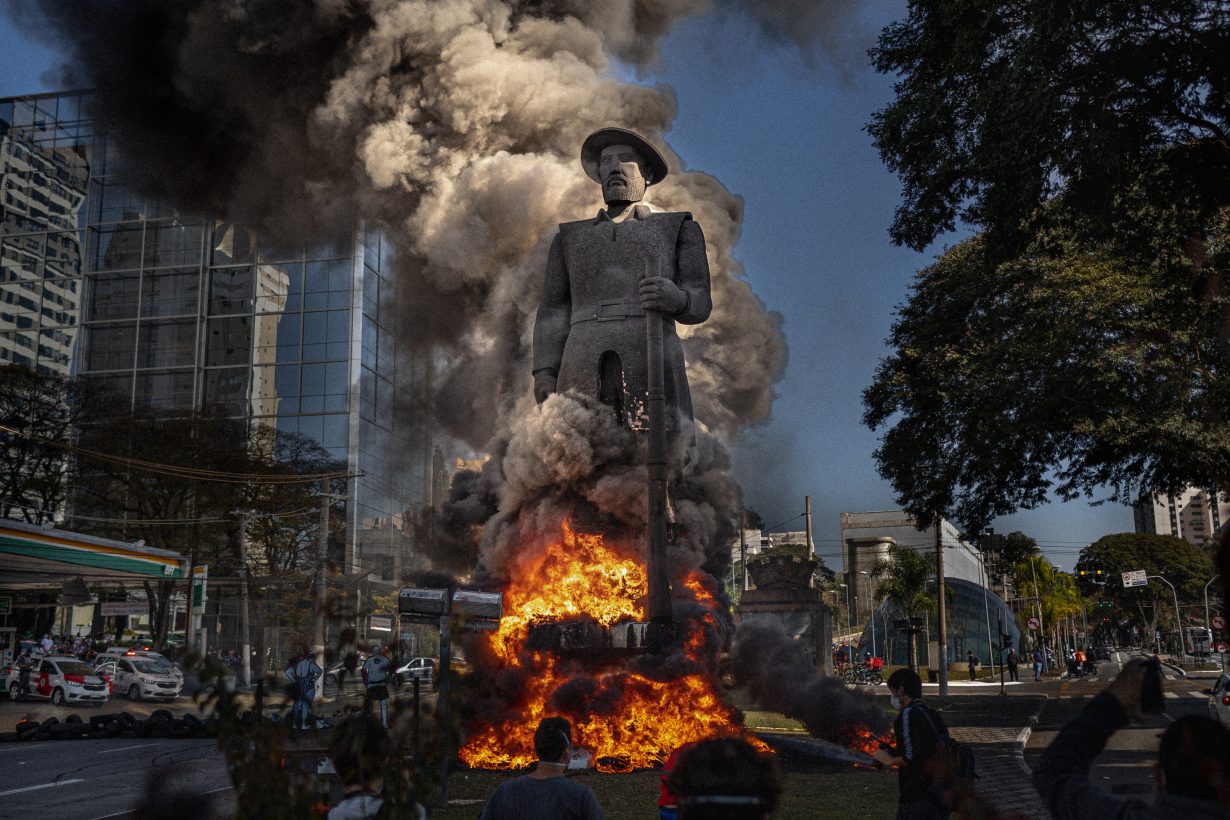
It was a hot day in São Paulo on Saturday and, on a busy intersection in the southwest of the city shortly after midday, it got hotter still. Under bright sunlight, a truck pulled up, its box trailer piled with car tyres. A group of around fifteen people, wearing balaclavas, proceeded to lay them at the feet of the statue of the 17th-century settler Borba Gato. In a carefully coordinated operation the pyre was then set alight: huge flames and great clouds of thick black smoke engulfed the ten-metre figure, captured by a professional photographer and videographer. Uploaded within minutes, all against the backdrop of the anti-Bolsonaro protests currently sweeping the country, Brazil’s first foray into the global statue wars was soon making the inevitable noise on social media. An Instagram account of a group calling themselves Revolução Periférica (Peripheral Revolution – a reference to the disenfranchised of the city’s outer suburbs), who seem to be the authors of the action, acted as a digital hub from which photos and video clips were endlessly shared. By Sunday the pictures had made it to most of the newspaper front-pages too; inside politicians, activists and art historians offered their opinions.
Manuel de Borba Gato was a Portuguese bandeirante – the name for the fortune hunters that came to Brazil from Europe in the sixteenth and seventeenth centuries. He and his family cast thousands of indigenous Brazilians into slavery; many índios were taken away from their own lands and put to work on a vast estate that lay where the São Paulo district of Pinheiros now stands, a little north of the statue commemorating these violent exploits. Like most of these buccaneers, Borba Gato also acted as a quasi-military force for the Portuguese state, forcing indigenous resistance into submission, often exterminating whole populations if necessary. The family were also responsible for opening up Minas Gerais to Europeans, catalysing a catastrophic gold rush that brought disease and famine to the interior. In short: Borba Gato was not a nice man. Historical figures often have mixed and muddled history, yet there is not much that can redeem the reputation of the man who went up in flames this weekend. He was not a hero, but a genocidal maniac bent on self-enrichment off the blood of others.
Inconveniently, the statue that towers over Avenida Santo Amaro had some aesthetic merit (compared at least to deathly bronzes that historical memorials are normally typified by). Unveiled in 1963 by artist Júlio Guerra, it is a hollow construction, supported by repurposed tram tracks (from the transport system ripped up in the later 1950s, itself an act of civic vandalism), the shell attractively peppered with stones and mortar. The slaver is shown with crushingly large boots and a musket which he thrusts fearsomely in front of him. Nonetheless it had the charm of vernacular Brazilian folk art, eschewing the imported kitsch of European statuary. By Saturday afternoon much of the lower half of the military man was left charred.
My reaction to the burning of Borba Gato was initially mixed. My support for the destruction of such a violent symbol – one that isn’t just a forgotten history but is regularly venerated by the far-right here – was tempered by the knowledge of how the previous statue skirmishes in the global North have often proved limp media-fuelled ding-dongs. These proxy fights are relished by right-wing and regressive forces as it enables them to shape their own divisive political narratives – already pro-Bolsonaro supporters were using Saturday’s protest to stoke fears of a ‘communist’ mob – into a culture war which diverts the Left’s own energy from more material fights against inequality and injustice.
Then the art critic kicked in: the purpose of memorials are to encapsulate social and cultural memories. The assault was carefully – and very cleverly – choreographed by those responsible: he was not toppled or graffitied, but burned. And those flames recalled recent events of far worse destruction. It is telling that the state authorities have already announced one arrest (having previously made moves to protect the statue with fencing and security): the man they claim drove the truck. Compare this efficiency to the sluggish reaction to other fires in Brazil: the massive inferno that gutted the National Museum in Rio de Janeiro in 2018 for example, or the fire that wiped out the snake bank of São Paulo’s Butantan Institute in 2010 and the destruction of the city’s Museum of Portuguese Language in 2015 (in which one firefighter also lost their life); or the horrific damage wrought on the Museum of Natural Sciences in Belo Horizonte in 2013, a precursor to the same city’s Natural History Museum going up in flames last June. Each time no lessons were learned, little in the way of prosecutions are made.
Yet, most of all, compare the desire of Brazilian conservatives to keep Borba Gato standing in São Paulo, while last year, 4,000km north, more than 2,500 major fires burned through the Amazon. While the statue wars of Europe and North America could be dismissed as tit-for-tat partisan wrestling over history, this statue represents the very real and very current destruction of indigenous land rights occurring today. The lighting up of Borba Gato was more than just symbolism.